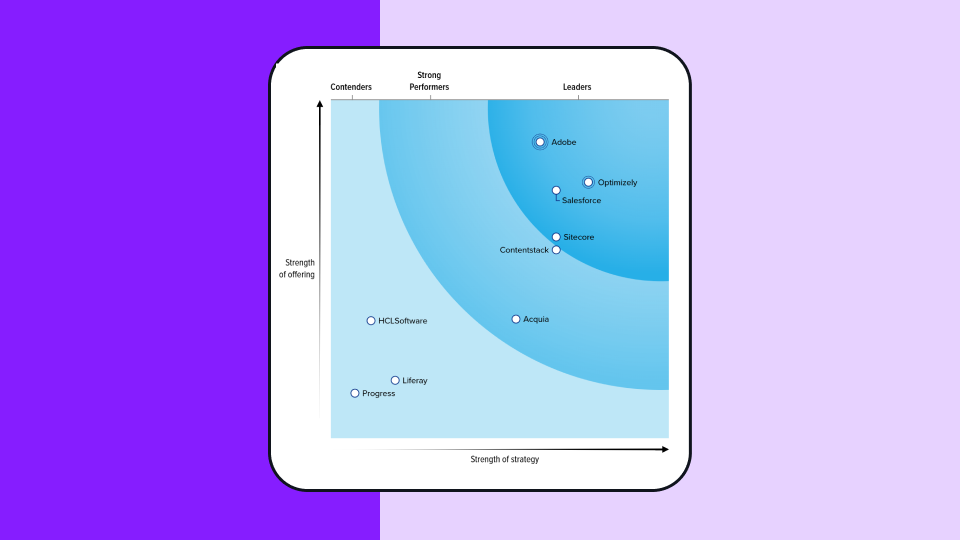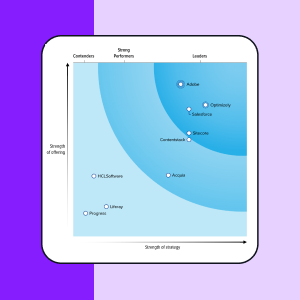Content recommendation engine
What is a content recommendation engine?
A content recommendation engine is a tool that uses data and algorithms to suggest content to users based on their preferences, behavior, and interests. It's a system that learns from your audience’s interactions and tailors content to match their needs. It works behind the scenes, learning what your visitors like and serving up content tailored to them. You’ve likely seen content recommendation engines in action without even realizing it, from the “You might also like” section on a blog to product recommendations while shopping online.
Another example of this is Netflix’s recommendation system. After watching a show or movie, Netflix suggests similar content based on what you’ve already viewed. Similarly, an online store like Amazon uses recommendation engines to suggest products based on your browsing and purchase history.
For marketers, content recommendation engines can help you deliver the right content to the right people at the right time, boosting engagement and conversions.
Key takeaways
-
A content recommendation engine provides personalized content and suggestions to website visitors to optimize their experience
-
There are four steps involved in content recommendation: data collection, data storage, data analysis and data filtering
-
Collaborative filtering makes recommendations based on how similar a user is to other users
-
Content-based filtering makes recommendations based on a user's likes and dislikes
-
The hybrid recommendation model uses a mix of both collaborative and content-based filtering to make the most accurate recommendations
What does a content recommendation engine do?
A content recommendation engine is a software solution that creates personalized user experiences by analyzing user and product data. The engine looks at a user's past online behavior, their likes and dislikes, and other key information, and uses that data to supply personalized content or make buying or viewing recommendations specific to that user.
It is through the use of content recommendation engines that Amazon can recommend products to you when you're shopping online, or Netflix can suggest new shows and movies you might like to watch. If you're brand new to the site, you might not find many recommendations -- or the recommendations you do have may not be useful. But as you continue to use the site and the site gets to know what you like and dislike, you'll find more and more accurate suggestions.
Some content recommendation engines feed dynamic content to the webpages you visit. Based on your past viewing behavior -- and the viewing behavior of other users like you -- the content recommendation engine can automatically generate personalized content as you scroll down the page.
Users like content recommendation because it provides them with a more personalized experience. Companies like recommendation engines because a more personalized user experience leads to increased viewership and purchases. It's a win-win for all involved.
Why content recommendations are important
Content recommendations help guide users to more content they’ll love. Rather than leaving your site after reading one blog post or watching one video, well-placed recommendations can keep your audience engaged longer. By suggesting related content, you show visitors that you “get” them, which makes them more likely to stick around and explore more of your content.
When you you consistently offer relevant content to your users, it builds trust, strengthens connections, and ultimately boosts conversions. For example, imagine a user reading a blog post about Instagram marketing. If you then recommend an article on building a killer Instagram bio or optimizing ads, they’ll likely click through and spend more time on your site. More time means more chances to turn visitors into loyal customers.
The benefits of content recommendation engines
Content recommendation engines offer several benefits to marketers looking to improve their customer engagement and retention strategies:
- Increased engagement: When users see content that resonates with them, they’re more likely to stick around. Take YouTube’s autoplay function as an example. You finish one video and another one plays that’s just as relevant.
- Better conversion rates: By personalizing content recommendations to your audience, they’re far more likely to convert. If you’re trying to get your site visitors to subscribe or make a purchase, tailored content suggestions go a long way. Ecommerce sites, like Amazon, use this strategy effectively to suggest products and drive more sales.
- Improved user experience: Content recommendation engines make for a more seamless user journey. No more wading through a sea of content means less friction and a more enjoyable user experience.
- Enhanced personalization: Content recommendation engines use individual user data to deliver tailored content suggestions, which makes personalizing content less of a manual lift for your marketing team.
- Increased loyalty: By consistently delivering relevant content to your audience, you’re making it far more likely that they’ll come back and, at some stage, convert into paying customers.
How does a content recommendation engine work?
Content recommendation is typically a four-step process. It's a matter of collecting data, storing that data, analyzing the data and then filtering the data to yield recommendations.
-
Data collection
All content recommendation engines need data on which to base their recommendations. These metrics can be about the user (demographic information, buying/viewing habits, etc.) or about the products (keywords, description, etc.). Some data is explicit (gathered from customer input); some is implicit (garnered from customer behavior, such as order history). -
Data storage
The dataset collected must be stored in some sort of database, such as an SQL database so it can execute the recommendation algorithm. -
Data analysis
The content recommendation system then analyzes the stored data and looks for relationships between data points. This can take place in real time or via a non-dynamic batched analysis. -
Data filtering
The final step in the content recommendation process filters the data to obtain the relevant information necessary to make an accurate recommendation to the user. This is typically done via some sort of algorithm -- collaborative, content-based, or a hybrid of the two approaches.
Types of filtering engines
There are three primary types of filtering used for content recommendation. Some models use collaborative filtering, some use content-based filtering, and some use a hybrid of those two methods.
-
Collaborative filtering
Collaborative filtering gathers and analyzes a variety of data to predict what users will like, based on how similar a user is to other users. A collaborative filtering engine uses information about users' activities, behaviors and preferences, such as whether they like certain foods, movies or clothing. Predictions are made using various machine learning techniques.
The advantage of collaborative filtering is that it doesn't actually analyze or understand the underlying content. It simply picks content based on what is known about the user. That's also a disadvantage, as the recommendations often bear only surface-level similarities to what the user actually likes.
For example, if user A likes the same TV shows as user B, and user A also likes polo shirts, a collaborative filtering engine might surmise that user B would also like polo shirts and recommend polo shirt-related content to that person. If recommendations are based on enough data points, they can be surprisingly accurate. Recommendations based on fewer data points, however, may result in only superficial recommendations.
Amazon uses collaborative filtering for its recommendation engine. Amazon employs sophisticated algorithms to recommend similar products based on what customers have recently purchased to sustain retention. The site then displays those recommendations in the "Items you may like" section on each product page. -
Content-based filtering
Content-based filtering takes a different approach. This type of engine leverages artificial intelligence to recommend items similar to ones the user has previously viewed or purchased in an effort to enhance the customer experience.
The thinking is that if a person likes item A, and item B is similar to item A, then the person will also like item B. For example, if a user has watched or purchased one or more Marvel movies, the content-based filtering engine might recommend a Marvel TV show to that user, because they are obviously similar in content.
The effectiveness of content-based filtering is limited to recommending similar types of content or items to similar users. For example, knowing a user's movie preferences would be of little help in determining what types of foods that person would like.
For a good example of content-based filtering, look no further than Facebook. When Facebook recommends potential friends for you, it does so based on your personal content — where you live, where you've worked, where you went to school. It's almost pure content-based filtering. -
Hybrid recommendation
The hybrid recommendation model blends the collaborative and content-based filtering models. It looks at both customer usage data and content descriptions, and as such produces more accurate recommendations than either individual method.
Netflix represents a real-world example of employing the hybrid recommendation model. To provide recommendations to its viewers, Netflix looks at the shows similar viewers have watched, as well as the content of shows you have watched. The resulting recommendations are more personalized than could be achieved otherwise — and account for 75% of what viewers watch on the service.
Examples of content recommendations
Content recommendation engines have a ton of different practical applications, including:
- Blog recommendations: After a user is done reading a blog post, you could recommend topically related articles. Let’s say they’ve read a blog post covering popular email marketing strategies. You could suggest a post on A/B testing subject lines or emojis that compel the most clicks — bringing people deeper into your content ecosystem.
- Product recommendations: You see a lot of this on ecommerce sites. After you've looked at a pair of trainers, the site might recommend matching accessories or similar styles, encouraging you to add more products to your cart.
- Video recommendations: YouTube does this beautifully by suggesting relevant videos based on what you’ve already watched. For marketers, this can be a powerful way to keep people watching your videos and deepen their engagement with your brand.
- Email content suggestions: Personalized email campaigns use recommendation engines to suggest blog posts, products, or offers based on a subscriber’s activity.
Use cases for content recommendation platforms
Marketers across industries can benefit from content recommendation platforms in several ways. Some key use cases include:
- Ecommerce personalization: Content recommendation engines can be used to cross-sell closely related products or upsell visitors on a more premium version of the product. Shopify, for example, often recommends complementary products to bump up the average order value.
- Content marketing: For blogs, content recommendation engines help keep readers engaged by suggesting more content that matches their interests, resulting in longer session times and (ideally) more conversions.
- Video marketing: If you use video content to engage with your audience, a recommendation engine can help surface related videos to keep viewers on your site longer and deepen their engagement with your brand. Think of how Netflix keeps you watching for longer than you'd planned with its “because you watched…” suggestions.
- Email marketing: Personalized offers or content recommendations in email campaigns can boost click-through rates and drive more traffic to your website.
- Subscription services: Subscription-based apps, like Spotify, or streaming services like Netflix, do a really good job of using content recommendations to keep their customers engaged and stop them from churning. It’s a win for the customer, too — no more endless scrolling to find something they like.
The future of content recommendation engines
In time, content recommendation engines are only going to get smarter — and more powerful. The more you can deliver hyper-personalized content, the more your audience will engage with your brand, helping you build deeper customer connections and drive conversions.

